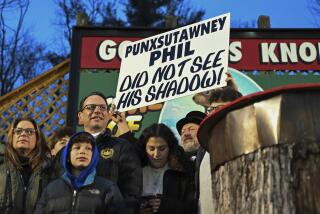It holds up again and again and . . .
Fifteen years after its release, “Groundhog Day” (Sony, $19.94) seems as strange and singular as ever: a Hollywood romantic comedy that could double as a Zen koan or an existential nightmare, depending on how you look at it. Harold Ramis’ high-concept classic, reissued in an anniversary edition last week, is a movie premised on relentless repetition and is itself surprisingly well-suited to multiple viewings.
Bill Murray, in perhaps the defining role of his career, plays Phil Connors, a jaded TV weatherman dispatched to Punxsutawney, Pa., to cover the annual Groundhog Day ceremony in which the arrival of spring is predicted by the whims of a hibernating rodent. Stuck in town because of an unexpected blizzard, he wakes the next morning to find he’s trapped in a time warp, condemned to live Feb. 2 ad infinitum, roused at 6 a.m. every day by Sonny and Cher’s “I Got You Babe” on the clock radio.
There is a suggestion that Phil’s fate is cosmic punishment for his hubris and general obnoxiousness (“I make the weather!” he declares when he learns of the blizzard that prevents him from heading home to Pittsburgh). But the genius of Ramis and Danny Rubin’s script is that, unlike most Hollywood films that flirt with the metaphysical, it never attempts to explain how or why its hero is confined to an eternal present.
Phil’s predicament may be absurd, but his response to it, which ranges from relishing his godlike omniscience to nearly losing his mind, is thoroughly and plausibly explored. His amnesiac universe, resetting itself at the end of each day, allows for bad or amoral behavior (he perfects his pickup technique, robs an armored car and punches an annoying old high-school classmate in the face). But it’s also cause for mind-numbing despair: There’s a black-comic montage of suicide attempts.
Eventually the purgatorial constancy of his day-to-day existence impels Phil to investigate his capacity for change. In what begins as an attempt to seduce his unfailingly sunny producer turned love interest (Andie MacDowell), he embarks on a regimen of self-improvement. With this much time on his hands, why not master the piano, ice sculpture and romantic French poetry? But Phil doesn’t just acquire skills and knowledge; he becomes, quite convincingly and with a minimum of sentimentality, a better person. This sarcastic narcissist evolves into an all-seeing good Samaritan: racing to catch a boy as he falls from a tree, returning nightly to a restaurant to perform the Heimlich maneuver on a choking diner, working frantically to reverse a homeless man’s fate.
It’s no surprise that “Groundhog Day” has acquired a following that’s literally devoted. Theologians have dissected its mystical subtext, and religious leaders have noted its relevance to their respective faiths, citing the Buddhist concept of the cycle of rebirth and suffering or the Jewish notion of being returned to Earth to perform good deeds. A series on faith and film at New York’s Museum of Modern Art several years ago included “Groundhog Day” alongside more obviously spiritual fare by Robert Bresson and Andrei Tarkovsky. And it’s not just the devout who have found the film resonant: Psychotherapists point to its time-looping premise as a metaphor for arrested development.
In its way, even more than such later showcases as “Lost in Translation” and “Broken Flowers,” “Groundhog Day” is also the ultimate Bill Murray vehicle. The star’s supremely jaded persona is here analyzed, undermined, depleted and finally redeemed. But despite that feel-good arc, the movie retains an edge of ambiguity. Seen one way, it’s an inspiring parable of human perfectability. Even a jerk like Phil has the potential to emerge finally as a paragon of decency. But the message is, of course, double-edged. It’s the kind of transformative feat that might require endless tries, if not several lifetimes.
More to Read
Only good movies
Get the Indie Focus newsletter, Mark Olsen's weekly guide to the world of cinema.
You may occasionally receive promotional content from the Los Angeles Times.









